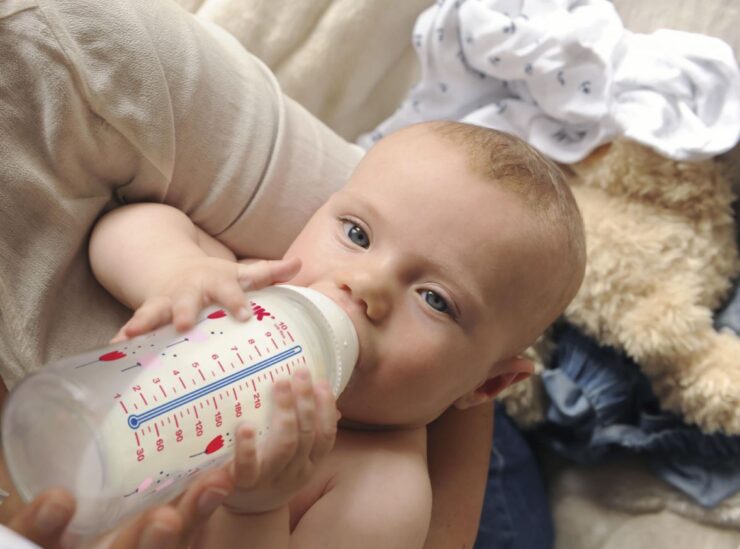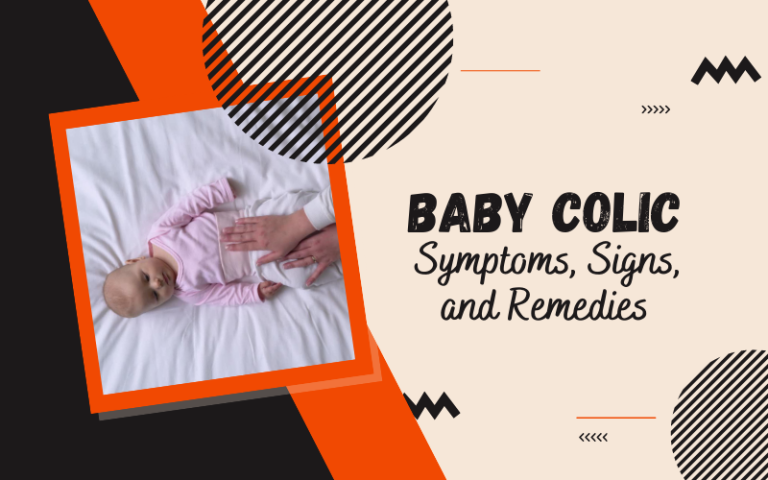All babies cry when they are distressed.
This normally includes crying for attention; crying for food, and crying when there is discomfort.
However, when a baby gets colic, the baby will cry continuously for hours without stop. The crying seems uncontrollable and in many cases, the baby is actually screaming.
This is very distressful for parents (especially first-timers) as they try to determine the cause of the crying and yet the baby seems inconsolable.
What is Baby Colic? Overview of Baby Colic
The general ‘rule of thumb’ used to determine whether a baby has colic is when the baby cries for more than three hours a day for more than three days a week.
It has been observed that between ten to twenty percent of all babies normally develop colic.
It affects baby boys and girls equally; and it does not matter whether the baby is a firstborn, a middle child, or the youngest in the family.
Colic normally peaks at about six to eight weeks after birth and then suddenly improves markedly after eight to twelve weeks after birth.
All parents should note that colic is not an illness or a disease. Instead, it is merely a pattern of crying (excessive in most cases) that has no apparent cause.
The baby is otherwise healthy, well-fed and growing both mentally and physically. There are also no known long-term negative effects of colic on the baby.
In fact, the main problem caused by colic is the stress and worry it causes the parents. The home becomes tense and everyone gets jittery whenever the colicky baby starts to cry.
Although it is extremely frustrating handling babies with colic, parents can take heart that this is not permanent and that many other parents also go through the same thing.
Symptoms of Colic
The main symptom to look for is uncontrollable and inconsolable crying for long periods. The intensity and intervals of crying will vary from baby to baby. Colic also normally comes in a series of ‘attacks’.
When a baby’s bout seems to end and the baby is calming down, the next bout starts again suddenly and the baby will start crying uncontrollably again.
This normally continues until the baby finally settles down and is tired enough to fall asleep.
When the baby cries, the baby will normally curl up and draw their hands and feet inwards. Sometimes, this is alternated with the baby stretching his hands and feet outward.
The small hands and feet are normally cold and clenched. As the baby cries, the baby normally turns red in the face (which is normal when someone screams) and passes the wind.
It is quite obvious that these symptoms are usually associated with that of someone in pain.
However, it should be noted that it is generally believed by the medical faculty that colic is not caused by pain nor does it cause pain to the baby.
The crying bouts can come at any time of the day but it is generally observed that it is much more common in the evenings.
Since the crying bouts are stretched over a long period of time, it disrupts the sleeping and feeding patterns of the baby.
As such, it is quite common to observe that babies with colic take a longer time to finish their meals; and have difficulty falling and staying asleep.
What Causes Colic?

It is actually not known what the cause of colic is. It is generally believed that colic is not caused by a medical problem because other than the crying bouts, the baby is otherwise healthy and growing.
With parents and professional caregivers so eager to please the baby to stop the crying, it is also believed that colic is not caused by the way the babies are handled.
Research has explored as suggested many possibilities – these possibilities are normally around the few areas of an immature digestive system, the baby’s temperament, wind in the intestinal system and lactose intolerance.
However, there is little evidence to confirm any of the suggestions.
Immatured Digestive System
Since babies are still growing and their digestive system has not matured, it is suggested that the baby sometimes get cramps as the milk passes through their digestive system.
These cramps are thought to be caused by the contractions in the digestive system that are necessary to pass the food through the system.
Another possibility that is suggested is that sometimes the digestive system gets confused and backs the milk up from the stomach to the throat.
Temperament
It is also observed that babies with colic seem to demand more attention and are more sensitive to their environment.
As such, the colicky baby’s temperament may cause the baby to cry like a normal reaction to the lack of attention or stimulation by the environment that the baby is in.
Although the crying is a normal reaction, the temperamental baby’s crying does not stop because the baby’s nervous system is not matured enough to regulate the crying properly.
Wind in the Intestinal System
When a baby feeds, the baby may not be efficient and may swallow tiny bubbles of air together with the milk.
It has been suggested that these bubbles get introduced through badly designed baby bottles or by the baby not latching properly on the mother’s nipples.
In any event, these bubbles are thought to accumulate in the baby’s intestinal system and cause bloating and pain.
This causes observation where the baby passes wind when the baby is going through a colic crying bout.
Lactose Intolerance
Before the age of eight to twelve weeks, a baby’s digestive system may not be able to produce enough lactase to break down the lactose present in the formula milk that the baby is fed.
In some cases, lactose is also found in breast milk as the lactose introduced into the milk through the mother’s diet of dairy products.
The undigested lactose can sometimes build up in the intestines causing discomfort to the baby.
Breastfed Babies and Colic: Know the Facts

As there are so many theories regarding what causes colic it can get very frustrating and even overwhelming for parents.
And many times the internet does not help, rather it seems to exacerbate the problem. Website after website seems to just add to the confusion.
For this reason, I want to introduce you to a source that is absolutely phenomenal.
The International Breastfeeding Centre, located in Toronto, Ontario, more commonly known as IBC. They are truly the leaders when it comes to understanding the whole phenomenon of breastfeeding.
I’ve summarized some key points from an excellent article, but I highly recommend that you go and have a read through the entire article yourself.
Top 10 Things You Need to Know About Colic in Breastfed Babies
- A baby that is not able to tolerate milk is not necessarily lactose intolerant.
- Sucking on the breast during feedings does not necessarily mean that the baby is ingesting milk.
- Your baby should decide when they are full and or ready for the other breast.
- The fat content in your milk may be insufficient.
- Mother’s breast milk is the best choice if it is an option.
- Your baby may be getting too much milk too fast into the intestine.
- You should not feed your baby according to a schedule.
- A baby that pushes away from the breast does not necessarily mean that they are full.
- Your baby may be reacting to the protein in cow’s milk or other foods that you are eating.
- Your baby may be gaining weight, yet still, be hungry.
What You Eat Matters

Proteins from the mother’s diet can get transferred to the baby directly from the breast milk. In most cases this is a good thing, however, in colic breastfed babies it is not.
These proteins can have an effect on the baby and may be the cause of their colic.
Quite often the most vicious of culprits are cow’s milk, while other foods as well can have an impact.
A great way to test the cow’s milk theory is to do an elimination diet. Start by completely eliminating all sources of dairy for a short period of time.
One to two weeks seems to be long enough to see if it has an impact on the baby’s colic. If so, then it would be wise to eliminate dairy while lactating.
Secondly, you can further test this theory by slowly re-introducing dairy back into your diet. Start with only one type of dairy product.
For example, try consuming small amounts of cheese and if there is no effect add in another item like yogurt and so on.
Some babies seem to tolerate some things, while others won’t tolerate any cow’s milk whatsoever. If however there is no change, then try eliminating another food source.
Some mothers have stayed away from all foods that produce abdominal gas and found this to be helpful.
Others have tried eliminating chocolate, onions, broccoli, bananas, etc. Working with a Naturopathic Doctor on an elimination diet can be extremely beneficial.
How to Soothe Colic Baby
Since there is no known and confirmed cause for colic, there is also no confirmed treatment for colic.
There are some medicines can be used to reduce discomfort (not to treat) the symptoms of colic.
These medicines normally help to even the abdominal-related symptoms.
Medicines that are available over-the-counter and do not require a medical prescription include colic drops (commonly known as gripe water).
Medicines that are normally prescribed by a doctor include Infacol or Disflatyl which can help to relieve wind that is trapped in the digestive system.
Besides medical relief, there are also several measures that help in reducing the symptoms.
In fact, most literature and baby doctors suggest measures to soothe and comfort the baby instead of medical treatments for colic.
Since different babies react differently to the different measures, parents should try as many of them as possible to determine which measures work best for their babies.
Overfeeding
Parents should not overfeed a baby with colic. Overfeeding causes distress to the digestive system which may worsen colic symptoms.
If the baby has colic, try as much as possible to stick to the baby’s regular feeding pattern – both in terms of schedule and amount (of course, it should be noted that as a baby grows, the required intake should increase accordingly).
Amounts can be regulated by measurements in terms of ounces (for bottle-fed babies) or the number of minutes (for breastfed babies).
Food Content
For bottle-fed babies, the amount of lactose in the baby’s feed can be reduced by choosing low-allergy formulas.
For breastfed babies, mothers should avoid dairy products in their diet. Besides dairy products, it is also observed that some types of food seem to make colic worse and should be avoided by the mothers.
These include caffeine, alcohol, cruciferous vegetables (for example cabbage and sprouts); and ‘gas’-producing foods like beans, onions and garlic.
If the baby is being fed fruit juices, make sure that the juice is properly diluted. Undiluted juice will aggravate colic symptoms.
Buying Anti-Colic Baby Products
There are now a lot of products out there that are specifically designed to reduce colic in babies. These include swaddle blankets, colic relievers, and even feeding bottles.
There are specific anti-colic bottles as well as accessories that help reduce air going through to your baby’s tummy, thus greatly reducing colic.
If you want to read more on this topic or want to purchase baby anti-colic products, you can check out our guide to the best baby bottle for acid reflux.
Wind
In order to reduce the intake of air in the feed, mothers who breast-feed should get professional help to guide the mother to get the baby to latch on to the nipple properly.
If the baby is bottle-fed, parents can choose a bottle and teats that are specially designed to reduce the air swallowed by the baby.
If the baby is still bloated, try to ‘burp’ the baby frequently. Also, try carrying the baby in a front pouch-style carrier to reduce the pressure of the belly.
Soothe an Irritated Baby
When the baby is crying in a colic bout, it is very difficult to get the baby to stop crying. However, parents can try to comfort the baby to make it as soothing as possible for the baby.
Some tips include:
- Swaddling the baby in a comfortable blanket
- Warming the baby’s belly with a warm water bottle
- Keeping the baby in motion in a rocker or a sling
- Taking the baby for a ride or a walk
- Making a continuous vibrating-type noise (for example, the noise from a vacuum cleaner or a car engine).
These methods help soothe the baby and reduce crying.
Read more on Colic Remedies to Soothe Your Baby.
How Long Does Colic Last?

The baby’s parents would undoubtedly be stressed out when the baby is crying and screaming from colic.
It is a parent’s natural instinct to try to make the baby comfortable and the parent would be worried and stressed when the parent’s effort fails to stop the crying.
This is made worse and more challenging if the parent is already tired and frustrated, and can introduce significant tension in the parent-parent and parent-child relationship.
As such, parents should seek help and advice to cope with the problems caused by colic.
If the parent is too tired to take care of a crying child, it is best to get someone else to take over watching for the baby.
If there is no one available to take over, the parent should put the baby down in a safe place that does not require immediate supervision and walk away for a while to some nearby place to get some relief from the stress.
Crying by itself will not harm the baby and walking away for a while would be overall more positive than to have a frustrated parent trying to comfort an irritable baby.
Also, if the parent is already frustrated, the baby can pick up the emotion from the parent and make matters worse.
On the other hand, parents should not worry about spoiling the baby. It is ok to respond every time the baby cries.
If the baby has colic, it is probably more important to soothe the baby and reduce any discomfort rather than worry about the baby being spoilt.
Change Hands Periodically
Since it is important for the parent to get some time off for themselves, the parent should arrange for someone to take over periodically.
The best people to do this is the partner, a close friend or a relative.
Taking short breaks of an hour or two will do the parent and the parent-child relationship a world of good.
The parent should make sure that this time off is used to de-stress and relax instead of doing other things like house chores.
Some good suggestions include taking a quick nap, reading a book or simply sitting alone in the garden.
Get Emotional Support
The baby’s parents should also get emotional support from friends who have been through the experience of taking care of a baby suffering from colic.
If possible, the parents should join an online support forum or a local support group where they can share and talk about the problem.
Besides getting new tips that may help, the parents can also get encouragement knowing that there are other real people who are also facing the same problems.
When Is it Time to Seek Medical Help?

Although colic does not actually require real medical treatment, the baby’s doctor will be able to provide assurance that there is no serious problem and the baby is healthy otherwise.
This will give the parent the assurance and peace of mind that the baby is healthy and will help the parent cope better when the baby is crying.
Besides that, the baby’s doctor will also be able to give good and proper advice regarding the handling of a colicky baby.
So when should the parent decide to call on the doctor? The parent should do so when:
- The baby’s cry changes. If the baby’s cry changes, the cause for the crying could be different – i.e. from colic to some other serious problems that would require medical attention.
- The baby cries for longer than three to four hours a day
- The baby is behaving differently – even though the parent cannot really identify exactly what is causing the concern.
- The baby is not gaining weight. Whether or not the stop in growth is due to colic, something needs to be done to address the issue and a medical doctor is the best person to diagnose the problem and advise the parent.
- The baby does not stop showing colic symptoms even after the age when colic symptoms normally ease – i.e. eight to twelve weeks.
- The baby shows other symptoms like vomiting, fever or blood in the stools
Although there is no real test that can be performed on the baby to positively identify colic, a visit to the doctor can bring relief and assurance to the parents.
The visit may also discover other serious problems. As such, the parents should not feel shy to visit a doctor when there is a concern.
After all, a parent is the most familiar with the baby and will know the baby best.
A visit to the doctor is also valuable when a parent wants to confirm the suitability of a new ‘tip’ that has been recommended by a friend or relative.
There are many ‘cure’ stories and suggestions floating around and the parent may want to discuss them with a doctor before implementing them.
The doctor can help put such suggestions into the proper perspective for your consideration.
Research Finds Twist to What Causes Colic in Newborns
For years we have come to accept the definition of colic being a fussy baby.
One that has episodes of crying for no particular reason.
These children are otherwise considered to be healthy and colic viewed as a passing phase usually lasting only the first few months of life.
The exact criterion often used is periods of crying that lasts more than 3 hours daily, more than 3 days per week, and for longer than 3 weeks.
Colic Causes in Newborns May Not Be What We Thought
What causes colic in newborns has primarily been considered to be an abdominal issue.
Often referred to as “gastrointestinal pain”.
However, research is making us think differently. USA Today reported on a study released April 16, 2013, suggesting that colic may actually be symptomatic of infantile migraines (Source USA Today).
The study printed in the Journal of the American Medical Association indicated that “children diagnosed with migraine headaches were more likely to have experienced colic as infants (72.6%) than those who did not have migraine (26.5%)” (Source USA Today).
A second study done a year prior found that “…mothers who suffer from migraines are more than twice as likely to have babies with colic than mothers without a history of migraines” (Source USA Today).
Often thought of as simply a condition in adults could now be affecting our newborn children.
What we know about migraines is their direct association with neurological symptoms. They are very different from a tension headache and if you know anyone that suffers from them they will tell you so.
Some patients have reported having nausea, vomiting, dizziness, light sensitivities and extreme fatigue (Source USA Today).
Could this be what our babies are experiencing?
More Research is Needed
For years we have thought that we had some basic understanding of what causes colic in newborns, but we need to begin asking different kinds of questions.
Certainly, this research is old now and much more information is needed, but it is time to open our eyes and begin looking to the medical community for different types of answers.
As we do not have enough information yet we still need to rely on the past definition of colic and subscribe to the treatments that we do know.
Regardless of whether or not your child meets the 3-by-3-by-3 criterion having a fussy baby with crying outbursts can be very scary for the parents, especially if it is your first child.
What’s more important is to become cognizant of patterns.
What is the normal fussiness for your child?
Are they behaving in a way that is uncharacteristic?
And are calming methods used in the past still effective?
If any of these questions is off-kilter you need to see a doctor get a proper diagnosis.
Are you babies’ symptoms causes of colic or is something else going on?
Baby Colic Exercises to Help Reduce the Stress

I firmly believe that massage is so important for your baby’s wellbeing.
Human touch is so beneficial for both mother and baby as it helps your baby relax and create a special bond with one on one time between the two of you.
Also, certain massage techniques may also help get rid of trapped wind that can sometimes be a major cause of colic.
I have included a few simple ways to massage your baby to help relieve the discomfort associated with colic.
Calming a Baby With Colic
As mentioned before, trying to settle and comfort a colicky baby is not only distressing but it can be exhausting too.
What you need to remember throughout each colic episode is that it won’t last, it won’t have a long-lasting effect on the baby and you WILL get through it.
I found that if there was a sudden outburst (especially after a feed), or sometimes about an hour after, massage was one form of relief.
Below are some exercises and techniques for you to try. Usually, if your baby is crying uncontrollably don’t expect the crying to necessarily subside. Sometimes it may get worse.
Try to persevere as afterward is when you should see a positive effect. The first two massages are the moving of the legs – these are great because these messages have a great effect on stretching the gut.
Do the following:
- Lay baby on the back and stretch legs out and down. Gently lift and bend both legs (together) up towards the belly button. Hold for 10 seconds, relax and repeat 3 times.
- Next, with your baby lying on the back, gently lift the right leg up towards the left ear (but not as high). Hold for 10 seconds and relax. Repeat this exercise 3 times too. Then change side and repeat.
The next massage is working on the tummy and gently encouraging the movement of wind through the gut.
- Lay your baby on the back. With a little massage oil, gently but firmly massage around the belly button. Keep your hands on the tummy the whole time and continue to follow the same route. By doing this, you are gently helping to push trapped air through the lower intestine.
The next exercise is a gently indent with 2 fingers and then a quick release.
This can sometimes help release trapped air also in the area of the stomach where trapped air can accumulate. To find the correct spot, do the following:
- Lay baby on the back. From your baby’s belly button, go down diagonally on the right-hand side (the side of the appendix). Roughly half-way between the belly button and the groin is where you need to do the exercise. Gently push in with 2 fingers and release quickly. Repeat this 3 times.
The last exercise should work well in subsiding the cry in your baby if the crying is a lot. Don’t be surprised if your baby lets out some little “fluffs”. Better out than in!

